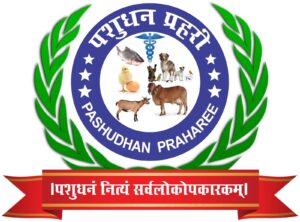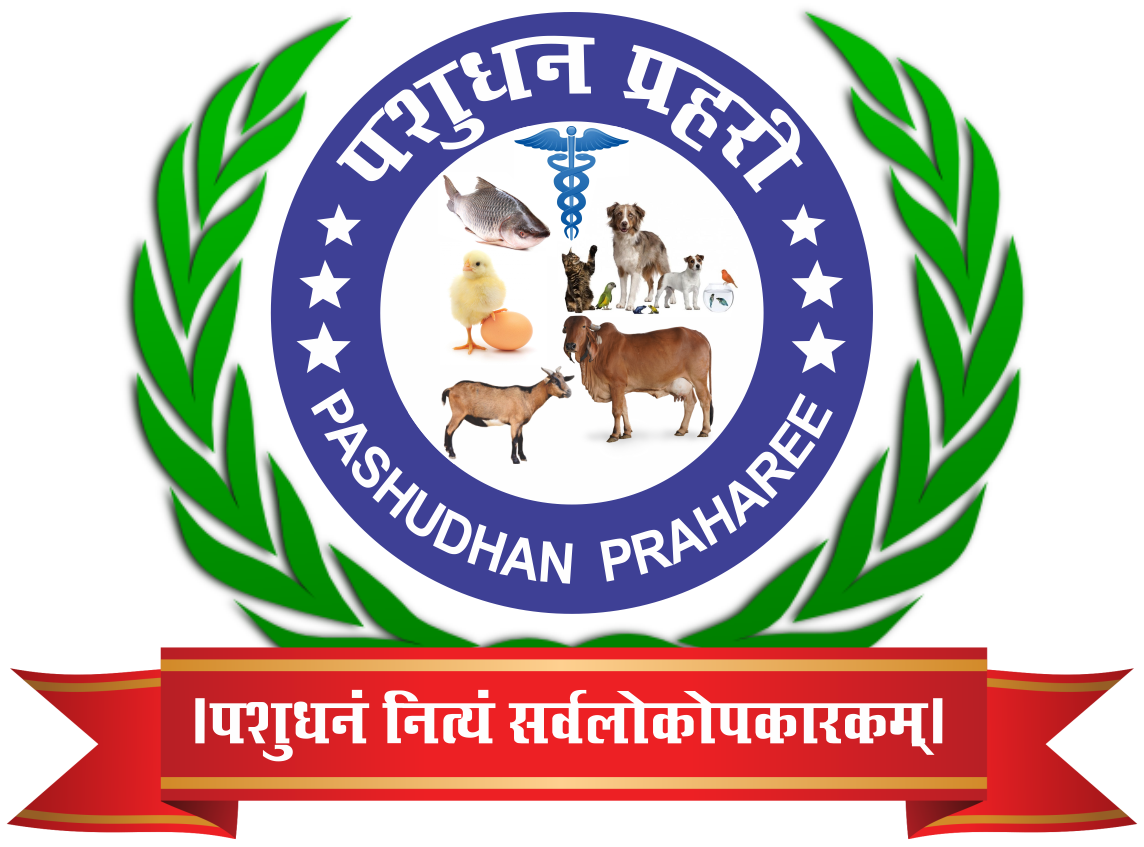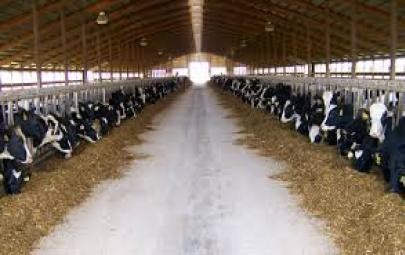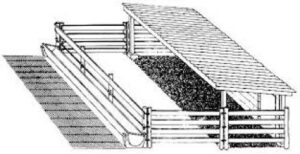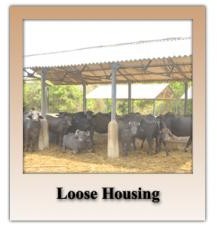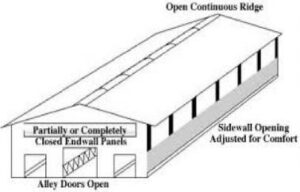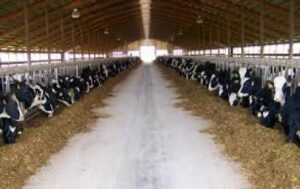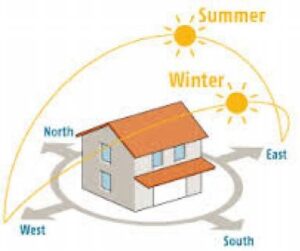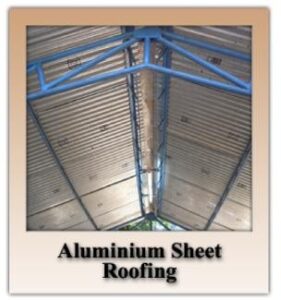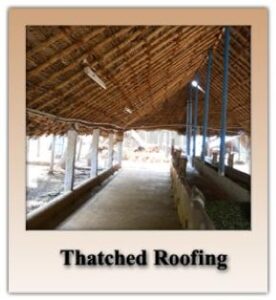SYSTEM OF HOUSING FOR DAIRY ANIMALS IN INDIA
S. S. Hanah, S. Deori, D. Medhi, Joken Bam and T.J. Ramesha
The main purpose of livestock production is to convert the energy in feed into products that can be utilized by human beings, such as milk, eggs, meat, wool, hair, hides and skins, draught power and manure (fertilizer). Traditional, extensive livestock production involving indigenous breeds and low-cost feeding will usually have low performance and can therefore only justify minimal, if any, expenditure for housing. However, where improved breeds, management and feeding are available it will usually be economically beneficial to increase the production intensity. Although this can be facilitated by, among other things, the construction of buildings and other livestock structures to provide for some environmental control, reduced waste of purchased feedstuffs and better control of diseases and parasites. For example, a relatively well constructed building for calving, furrowing, lambing etc. will provide a high level of environmental control and may improve the survival rate of neonatal animals, sufficiently to justify the cost and add to the profitability of the production unit.
The livestock animal has a certain fixed behavioral patterns, such as pecking in chickens and nursing in mammals. This behavior can influence the design of structures, as demonstrated in the examples given below. Cattle normally live in herds but, when giving birth, cows attempt to find a quiet, sheltered place away from the disturbance of other cows and humans. The cow needs to be alone with her calf for some time after birth for the cow/calf bond to be established. When a cow that is confined in a loose housing system is approaching calving, it should be removed from the herd and placed in an individual pen. Hens spend considerable time in the selection of a nest, which is on the ground. Nesting is characterized by secrecy and careful concealment. Hens in deep-litter systems therefore, sometimes lay eggs on the floor instead of in the nest boxes, especially if the litter is quite deep or there are dark corners in the pen.
Sows are nest-builders and should be transferred to clean furrowing pens one to two weeks before giving birth, and given some bedding with which they can build a nest. Oestrus, especially in gilts, is increased by the smell, sight and physical presence of a boar. Therefore, gilts and sows waiting for mating should be kept in pens adjoining the boar pen.
Cattle prefer to be able to see while drinking therefore, more animals can drink at once from a long, narrow trough than from a low round one. With cattle (and hens), feeding is typically a group activity, therefore space at the feed trough must be provided for all the animals at one time.
To prevent wasting feed, a trough should be designed to suit the particular behavior pattern that each species exhibits while feeding, i.e. pecking in hens; rooting with a forward and upward thrust in pigs; and wrapping their tongue around the feed (grass) and jerking the head forward in cattle. Sheep are vigilant and tight-flocking, and respond to disturbances by fleeing. Moreover, they move best from dark into light areas and dislike reflections, abrupt changes in light contrast and light shining through slats, grates or holes. Therefore, when designing the structures, all the species specific characters should be taken into account.
The welfare of an animal is very important while planning and designing of suitable housing accommodation for any livestock. Improper planning in the arrangement of animal housing may result in additional labour charges and that curtail the profit of the owner. As the principal function of any system of housing for animals are:
(i) Provision a congenial environment for better growth,reproduction and production performance
(ii) Provision of desirable working conditions for labour and supervisory staff and
(iii) integration of housing with feeding, watering, milking and manure handling systems.
In other words, housing management is more or less synonymous to the system of management of animals. The animals house should be properly located, constructed spaced out and grouped. The animal house may be constructed in different shape, type, etc. but health and comfort of the animals should receive special attention. Further a good animal house must permit a dry and comfortable surface for the animals to rest, that does not permit breeding of internal and external parasite and other pathogens within the shed. The good manager plan and build the animal house to reduce heat gain and promote heat loss from the structure of the house by radiation and conduction during summer. During winter the structures, especially those parts that come in constant physical contact with animals, like floor and walls, should not get too cold and should give protection from the cold winds.
Wherever they are housed animals are entitled to the Five Freedoms. Basic requirements such as an agreeable physical environment are necessary, and the animal should be well cared for.
The Five Freedoms are a set of five basic rules concerning the welfare of animals. They apply to the housing of both large and small animals.
They are as follows:
- Freedom from hunger and thirst
- Freedom from discomfort
- Freedom from pain, injury and disease
- Freedom to express normal behavior
- Freedom from fear and distress
Type and system of housing for animals:
The single housing system may not be wholly suitable for all agro-climatic zones in India, as the climate varies from region to region. Housing of the animal is therefore to be planned and designed as per the agro-climatic conditions prevailing in a particular area. The most widely prevalent practice in this country is to tie the cows with rope on a Katcha floor except some organized dairy farms belonging to government, co-operatives or military where proper housing facilities exist. It is quit easy to understand that unless cattle are provide with good housing facilities, the animals will move too far in or out of the standing space, defecating all round and even causing trampling and wasting of feed by stepping into the mangers. The animals will be exposed to extreme weather conditions all leading to bad health and lower production. For dairy cattle, it may be successfully housed under a wide variety of conditions, ranging from close confinement to little restrictions except at milking time. However, two types of dairy barns are in general use at the present time.
- The loose housing barn in combination with some type of milking barn or
- The conventional dairy
Each system has its own advantages and limitations. The final decision can be based upon the prevailing environmental condition of a particular area.
Loose housing
- It is a system of housing in which animals are kept loose in an open paddock in group (40-50) throughout the day and night except at the time of milking and some other specific purposes like treatment, breeding etc., when the animals are required to be tied.
- Common shelter is provided along one side of open paddock under which animals can retire when it is very hot or cold or during rains, enclosed by brick wall or railling.
- Common feed manger and water tank along with covered standing space is provided and concentrates are fed at the milking time which is done in a separate milking barn or parlour in which cows are secured at milking time and are milked.
Advantages
- Cost of construction is cheaper.
- Future expansion is possible.
- The animals will move freely so that it will get sufficient exercise.
- The animal can be kept clean.
- Common feeding and watering arrangement is possible.
- Clean milk production is possible because the animals are milked in a separate milking barn.
- Oestrus detection is easy.
- less prone to fire hazards to animals
- At least 10-15 percent more stock than standard can be accommodated for shorter periods.
Disadvantages
- It is not suitable for temperate Himalayan region and heavy rainfall areas
- It requires more floor space.
- There is competition for feed.
- Attention of individual animal is not possible
- A separate milking barn is needed for milking of animals.
Conventional barns or Stanchion barns
On the other hand in the conventional or stanchion barns closed system there is greater protection during winter season but proportionally the cost is very high.
- In this system of housing, the animals are confined together on a platform and secured at neck by stanchions or neck chain.
- The animals are fed as wells as milked in the same barn.
- These barns are completely covered with roofs and the sidewalls are closed with windows or ventilator located at suitable places to get more ventilation and lighting.
- It is applicable for temperate and heavy rainfall region.
The same type of housing can be utilized for tropical region with slight modification
Advantages
- The animals and men caring for animals are less exposed to harsh environment.
- The animals can be kept clean.
- Diseases are better control.
- Individual care can be given.
- Separate milking barn is not required.
Disadvantages
- Cost of construction is more.
- Future expansion is difficult.
- Not suitable for hot and humid climatic conditions.
Generally under conventional barn system animal are arranged in a single row if the numbers of animal are less, say 10 or in a double row if the herd is a large one. In double row housing, the animal should be so arranged that the Animal face out (tail to tail system) or face in (head to head system) as preferred. Ordinarily, not more than 80 to 100 cows should be placed in one building.
Advantages of tail to tail system
- Under the average conditions, 125 to 150 man hours of labour are required per cow per year. Study of Time: Time motion studies in dairies showed that 15% of the expended time is spent in front of the cow, and 25% in other parts of the barn and the milk house, and 60% of the time is spent behind the cows. ‘Time spent at the back of the cows is 4 times more than, the time spent in front of them.
- In cleaning and milking the cows, the wide middle alley is of great advantage.
- Lesser danger of spread of diseases from animal to animal.
- Cows can always get more fresh air from outside.
- The manager can inspect a greater number of milkmen while milking. This is possible because milkmen will be milking on both side.
- Any sort of minor disease or any change in the hind quarters of the animals can be detected quickly and evenautomatically
Disadvantages
- Spreading of diseases through digestive and reproductive system is high
- Drainage channel is not exposed to sunlight.
- Feeding of animals is laborious
Advantages of face to face system
- Cows make a better showing for visitors when heads are together.
- The cows feel easier to get into their stalls.
- Sun rays shine in the gutter where they are needed
- Feeding of cows is easier; both rows can be fed without back tracking.
- It is better for narrow barns
Housing at heavy rainfall areas:
The design of typical loose housing structure for the adult animals would be similar to general loose housing system except additional provision of covered resting area in one side of the paddock which will provide sufficient dry area for the animals during rainfall and provide protection against strong wind. The floor of the resting area should be slightly elevated from open paddock and one side should be closed with brick wall which will work as wind break.
Temperate high altitude areas:
In temperate area, partially loose housing along with the closed conventional system of housing is desirable. In this system due attention is given to protect animal from heavy snow fall, rain and strong wind. Tail to tail system of conventional barn, completely roofed and enclosed with side wall is suggested with adequate provision of tying, feeding, watering and milking inside of the barn. Open paddock area with continuous manger in one side along with covered standing space is provided attached to the barn for housing during warm/comfortable weather. In addition, the following important aspects also need adequate attention while deciding about the housing structure for dairy animals.
Orientation of animal house:
In general, animal sheds are located with long axis east to west the paddock side facing the north to get direct sunlight during winter and to prevent entry of direct sunlight into the shed during other seasons. In deciding which orientation to build, the following factors need be considered:
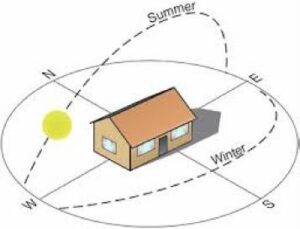 |
|
- With the east-west orientation the feed and water troughs can be under the shade which will allow the cows to eat and drink in shade at any time of the day. The shaded area, however, should be increased to 3 to 4m² per By locating the feed and water in the shade, feed consumption will be encouraged, but also more manure will be dropped in the shaded area which in turn will lead to dirty cows.
- With the north-south orientation, the sun will strike every part of the floor area under and on either side of the roof at some time during the day. This will help to keep the floored area A shaded area of 2.5 to 3m² per cow is adequate if feed and water troughs are placed away from the shaded area.
- If it is felt that paving is too costly, the north-south orientation is the best choice in order to keep the area as dry as possible.
- In regions where temperatures average 30°C or more for up to five hours per day during some period of the year, the east-west orientation is most beneficial.
Space requirement:
The Indian Standards Institution (ISI) has brought out certain standards of space requirement for farm animals. These standards are basically for loose housing.
 |
|
 |
|
Flooring materials:
Different materials are used for animal house flooring. The choice depends on availability and cost of the materials. Commonly used materials are: cement concrete floor, vitrified paving bricks, stones, building bricks and gravel
Roofing materials:
Different materials are used as roof covering. Careful selection of material is essential in tropical building to prevent the solar radiation. It is preferable to have material with low conductivity of heat. The commonly used roof materials are,
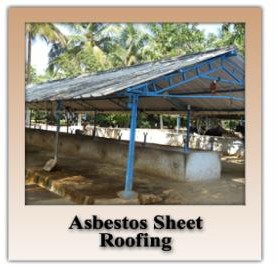 |
|
Sanitation in livestock housed:
Sanitation is another important point in managing the livestock house for eliminations of all micro organisms that are capable of causing disease to the animals. Dry floorings keeps the houses dry and protects from foot injury and breeding of pathogenic organism. Similarly the presence of flies and other insects in the livestock house not only , disturbs the animals but also spreads deadly diseases to the animals.
Sanitizers:
Sunlight is the most potent and powerful sanitizer which destroy most of the disease producing organism. Disinfection of animal sheds means making these free from disease producing bacteria and is mainly-carried out by sprinkling chemical agents such as bleaching powder, Iodine and lodophor, sodium carbonate, Washing soda, Slaked Lime (Calcium hydroxide), Quick Lime (Calcium oxide) and phenol.
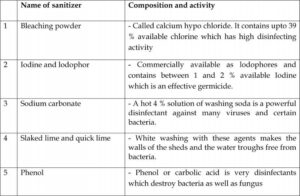 |
|
Insecticide:
Insecticides are the substances or preparations used for killing insects. In dairy farms, ticks usually hide in cracks and crevices of the walls and mangers. Smaller quantities of insecticide solutions are required for spraying. Liquid insecticides can be applied with a powerful sprayer, hand sprayer, a sponge or brush; commonly used insecticides are DDT, Gramaxane wettable powders, malathion, Sevin 50 % emulsifying concentration solutions. These are highly poisonous and need to be handled carefully and should not come in contact with food material, drinking, water, milk etc.
Procedure
- Remove the dung from the floor and urine channel with the help of a shovel and basket (iron) and transfer it to the wheel -borrow
- Remove the used bedding and leftovers from the mangers in a similar way.
- Empty the water trough and scrape its sides and bottom with the help of a floor brush.
- Wash the water trough with clean water and white wash it with the help of lime mixture once a week.
- Scrape the floor with a brush and broom and wash with water.
- Clean and disinfect the splashes of dung on the side walls, railing and stachions.
- Remove the cobwebs periodically with the help of a wall brush.
- Sprinkle one of the available disinfecting agents in the following Bleaching powder should have more than 30% available chlorine. Phenol 1-2% solution. Washing Soda (4% solution).
- Allow adequate sunlight to enter in to the shed.
- Spray insecticides at regular intervals especially during the rainy season (Fly season).
- Whitewash the walls periodically by mixing insecticides init to eliminate ticks and mites living in cracks and crevices.
Conclusion:
Safety and ease in handling a comfortable shed for protection from weather and a provision for exercise are the key points while planning housing accommodation for the livestock. The response of the animal to its environment is complex both in its biological responses and in the description of the environment. Knowing the factors that cause stress to the animal in mid and high altitude will greatly help the manager to plan properly for the construction of animal’s house.
https://www.pashudhanpraharee.com/housing-for-dairy-cattle/
source-DAIRY FARMING An approach for poverty alleviation of Tribal Farmers
References
Cai, L. and G. Wiener, 1995. The yak. FAO (Food and Agricultural Organization of the United Nations) Regional Office for Asia and the Pacific, Bangkok, Thailand.
Han, X. T., A. Y. Xie, X. C. Bi, S. J. Liu and L. H. Hu, 2002. Effects of high altitude and season on fasting heat production in the yak Bos grunniens or Poephagus grunniens. British Journal of Nutrition, 88: 189-197.
Wiener, G., H. Jianlin and L. Ruijun, 2003. The yak, 2nd edn. Published by FAO Regional Office for Asia and the Pacific.
Xu Guilin, 1983. Analysis of factors concerned with the milking performance and milk quality of yak. Journal of China Yak, 1: 21-29.
Yu, S.J., Huang, Y.M. and Chen, B.X. 1993. Reproductive patterns of the yak. 1.
Reproductive Phenomena of the female yak. British Veterinary Journal
149:579-583.
Zhang, R. C., 2000. Ecology and Biology of Yak Living in Qinghai-Tibetan Plateau. In: Recent Advances in Yak Reproduction, Zhao, X. X. and Zhang, R.
- (Eds.) Publisher: International Veterinary Information Service (www.ivis.org), Ithaca, New York, USA.
